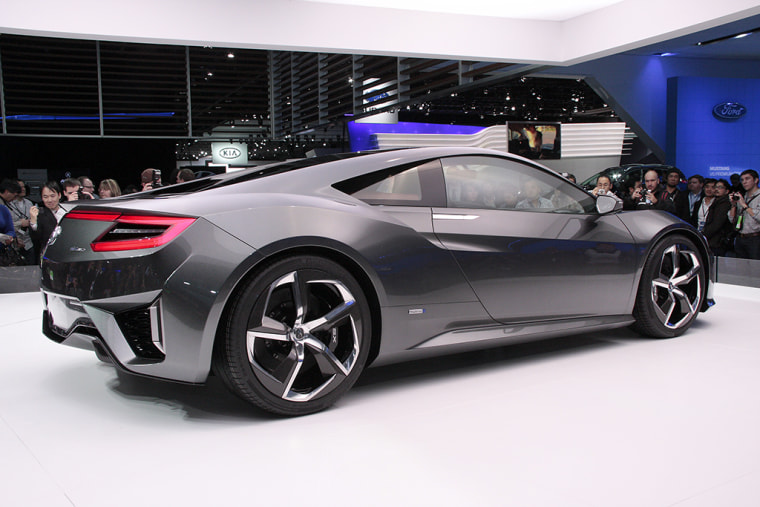These days, it’s common for automakers to display “concept cars” on the auto show circuit that are thinly disguised versions of upcoming production models – like the MDX Acura introduced at the Detroit Auto Show last month.
But the show car that drew the real crowds was a model that won’t hit the street for at least two years, the reincarnation of Acura’s once formidable NSX supercar.
The Japanese maker is desperately hoping that the re-born NSX will grab the high-line brand some much-needed attention and bring curious new shoppers into Acura showrooms even before it reaches production.
When it was launched more than a quarter-century ago, Acura transformed the way Americans thought about Japanese cars, proving that the Asians could challenge the well-established European and domestic luxury brands. But the initial success of the Honda Motor Co. subsidiary proved far too fleeting and in recent years, Acura has lagged in the back of the premium pack.
The Detroit Bureau: Despite Recent Price Spike, DoE Expects Gas to Level Off, Even Decline
“It was a brave experiment when it was first launched,” says automotive analyst George Peterson, of AutoPacific, Inc. And now, he adds, there are signs Acura “has hit bottom and is on the upswing.”
That was clearly something the maker intended to prove when it invited automotive journalists to the race track in Sonoma, California, several weeks back, to check out the new Acura RLX and pit it against some of its most formidable competitors, including the Mercedes-Benz E-Class and BMW 5-Series.
“This is a big deal for us,” asserted Mike Accavitti, the marque’s head of marketing. “It’s the best product we have ever built.”
What the Honda subsidiary has pronounced its new “flagship” is the direct heir to the original Acura Legend, a stylish and technically sophisticated product that turned conventional wisdom on its head. Produced in both coupe and sedan body styles, the original Acura model quickly ran up the sales chart and, if anything, created a conundrum for Honda officials who feared the Legend nameplate was better known than that of Acura itself.
The Detroit Bureau: Ford Looking to Novel Way to Get Back into Compact Pickup Market
Their solution proved disastrous. They not only replaced the Legend but switched to a new, European-style alphanumeric nameplate strategy for its replacement – and for the new models to follow. The problem is that the cache of the original products was lost and motorists became completely confused by the new names; was the new flagship the RL or TL was a frequently heard question.
“Internally, they believe that (name) change cost them $1.5 billion in lost sales,” says Peterson, who has worked with Acura strategists over the years to figure out how to regain lost momentum.
Compounding the situation, Acura faced a wave of new competitors, including the even more up-market Japanese upstarts Lexus and Infiniti, launched by Toyota and Nissan respectively, which looked at Acura as a “case study,” says the analyst.
Acura seemed to be regaining its footing in the early days of the new Millennium with an assortment of products such as the downsized RDX crossover, sales climbing to a record 209,610 in 2005 and putting it within striking distance of the first-tier luxury brands.
The Detroit Bureau: VW to Build 261 mpg 2-seater
But then, industry observers suggest, the Honda subsidiary again shot itself in the foot with a series of new mistakes, such as the introduction of an oversized chrome grille shield that has been derisively dubbed the “beak.”
The new RLX and upcoming MDX feature a significantly smaller version of that shiny proboscis, but Acura remains committed to the alphanumeric nameplate strategy despite senior officials admitting it still confuses many customers.
But they’re hoping that a broader product line that is receiving generally positive reviews will overcome such concerns. It should also help, said Accavitti, to have new products like the Acura RLX offered at prices “$1000s less than comparably equipped competitors.”
In keeping with its roots, meanwhile, the new models will also put an emphasis on advanced technologies, from state-of-the-art infotainment systems to the electric Super-Handling All-Wheel-Drive Acura will launch in the coming year.
That technical mouthful, abbreviated as e-SH-AWD, is a hybrid drivetrain that can deliver excellent fuel economy in routine driving but transform a vehicle like the RLX into a serious performance machine when the driver stomps the throttle. The unusual layout, which uses a V-6 gas engine and three electric motors also can direct power to individual wheels to help improve handling in aggressive turns, a concept known as torque vectoring.
An even more aggressive version of the system will be the fast-beating heart of the NSX, which is expected to debut in late 2014 or early 2015, Acura officials hint.
The maker clearly needs the boost. Sales tumbled to just 105,723 in 2009, a notably sharper downturn that the overall U.S. automotive market. Last year, the maker posted a strong gain, but at 156,216 cars and crossovers it was still down nearly 25% from its all-time high.
The new year is off to a good start, January volume up about 13%, year-over-year, buoyed by other new models such as the entry-lux sedan the Acura ILX.
Acura still has some serious challenges to overcome, but the maker appears to be making inroads after what some have dubbed a lost decade. It helps to have new products at the top and bottom of the luxury range – and a striking new NSX supercar in the offing that packs potential buyers in whenever it goes on display.
